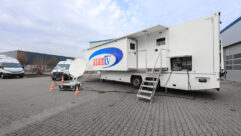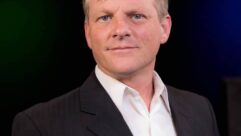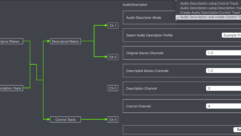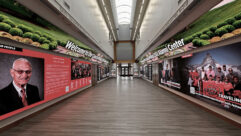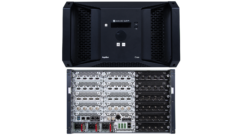
All Systems Go
May 1, 2004 12:00 PM,
By Bruce Borgerson
Crestron touch-panel provides local control of one of the systems.
When it comes to sheer vastness and total costs, Texas has to admit — reluctantly — that it has been trumped by Nevada in the hotel department. But that didn’t stop one new Houston convention hotel from taking a couple of Texas-size steps into tomorrow’s technology. Although modestly sized compared with the Las Vegas behemoths, Hilton Americas nevertheless boasts pioneering A/V installations that encompass everything from concert-quality, self-powered loudspeakers in the ceiling to fiber-optic connectivity clear through to the ballroom floor boxes.
THE LONG HAUL
To be sure, fiber-optic backbones in large hotel and resort properties are nothing new. Several new megaresorts in Las Vegas have opted for fiber backbones, if only because the sheer length of long-haul runs gives an immediate payback when compared with the cost of fat copper bundles. The 5,000-room MGM Grand, for example, covers a sprawling 115-acre site, making extensive fiber deployment practically a given.
In contrast, downtown Houston’s 1,200-room Hilton Americas is not such an obvious candidate for a full fiber treatment. Yet following the skeletal analogy, there the fiber goes from the backbone right down through the femur to the metatarsals. By taking this route all the way to the end, Hilton Americas has redefined the “long haul” in temporal rather than spatial terms: here the payback comes over time, not simply over distance.
Eighteen “Gumbies” are located throughout the facility.

This novel approach places Hilton Americas at the leading edge of a trend that is rapidly changing the fundamentals of hotel A/V system installation. From the beginning, hotel A/V systems have been built around dedicated runs of copper wire — all kinds of copper wire, each made for a particular purpose. The problem, of course, is that the requirements for dedicated wiring have changed, with increasing speed, from shielded audio and 70V to MATV coax to Cat-5, with each new technology bringing its unique demands. At some point, that means the hotel will require a major upgrade, complete with new cable runs and hundreds of new terminations. When you factor in lost revenue from downtime, such a wiring upgrade represents a major capital investment. Also, unlike plumbing fixtures or carpeting, the timing and costs for such technology-driven wiring overhauls cannot be fully anticipated.
KEEPING THE OPTIONS OPEN
As we plunge into the digital domain, the scenario changes. More and more, A/V systems involve moving massive amounts of data from one point to another. In designing systems for Hilton Americas, principal engineer Bill Schuermann of Houston-based HFP Acoustical Consultants squarely confronted this reality. He convinced the property’s architects and developers that it made more sense to install an easily upgradeable, high-bandwidth network, one that could more easily adapt to future media demands.
“One of the beauties of fiber is that you can leave your options open,” says Schuermann. “It’s just raw bandwidth. You can look at videoconferencing as one example. Most hotels will have a few rooms with a dedicated T1 line, but here we have T1 connectivity in every room and at every ballroom floor box because we simply patch it in from the control room. If you go to streaming media and high-definition video, you need lots of bandwidth and speed. So although we anticipate upgrades and changes, the infrastructure is broad enough and flexible enough to accommodate future demands.”
A SUPER KICKOFF
Hilton Americas opened on December 15, 2003, and quickly moved into the national spotlight when it served as the official host hotel for the NFL’s Super Bowl in early February. The A/V systems had a trial by fire in the days leading up to the big game, because the property was the site for several media events, lavish banquets, and corporate hospitality suites.

When the big game was over, Hilton Americas resumed its pivotal role in helping to move Houston into the first rank of major convention cities. Located across the street from the city’s George R. Brown Convention Center, with connecting pedestrian sky bridges between, the hotel offers 93,500 square feet of its own meeting space, including two subdivisible ballrooms (40,000 and 26,000 square feet) and 30 smaller meeting rooms.
Lead architect for the $385 million hotel development was Gensler and Associates. The owner and governing authority is the Houston Convention Center Hotel Corp., with operations and management assumed by the Hilton Hotels Corp. Ford Audio-Video, headquartered in Oklahoma City, was the primary A/V systems contractor. Gary Lambert served as Ford’s on-site job superintendent, and Gary Ewald — based in the company’s Austin, Texas, office — was project engineer.
Schuermann’s ambitious concept for A/V systems was driven by a goal to make Hilton Americas a model for future “production friendly” convention hotels. This ruling concept dictated some basic structural accommodations, including improved street access for production equipment and services, more rigging points, spotlight/camera rooms above the main ballroom, ample AC circuits for production lighting and audio, and undercarpet troughs throughout the ballrooms to accommodate camera cables and audio snakes.
Once those basic issues were resolved, Schuermann moved into the realm of cabling and connectivity, at which point he faced the question: Copper or fiber?
“My proposal was to take fiber a step further and bring it into the floor pockets and wall boxes,” Schuermann says. “First, that simplified the basic infrastructure of the project. But more important, in the long run, it gave the hotel operators more capabilities and connectivity throughout the property.”
The registration desk has 50-inch Fujitsu displays.

RIDING ON LIGHT
With few exceptions, all audio, video, and data signals for the hotel’s public and meeting spaces are carried on the fiber-optic network. That includes all the meeting/event audio and video systems, digital signage, background/paging audio, Ethernet, and control signals for the extensive Crestron system. In fact, the only system of any significance not carried on fiber is the Clear-Com production intercom, a dedicated self-standing system not in need of property-wide interconnectivity.
The fiber-optic network is woven throughout essentially all of the first four floors of the building: lobby areas, restaurant, bar, ballrooms, meeting rooms, and other public spaces. The same connectivity options are also available, as needed, in the fifth-floor executive conference room, the 23
rd
-floor exercise gym, and the 24
th
-floor bar/lounge and executive boardroom. Fiber connectivity is also key to an extensive broadcast interface, which provides multiple audio and video camera tie-lines between the two ballrooms and two street-level locations: the loading dock and the production entrance.
Physically, the fiber-optic network was constructed using Sumitomo Electric’s FutureFlex blown fiber system. The initial fiber installation, subcontracted to Southwest Networks, comprises nearly 150,000 feet of fiber, mostly single-strand single-mode but also comprising multistrand and multimode fiber runs. Additionally, the fiber network provides dark TX and RX fiber pairs to prime locations to allow for immediate expansion of digital connectivity as needed. About half the FutureFlex tubing is vacant to allow for future fiber additions, and all fiber runs can be quickly blown out and upgraded with higher-capacity strands as needed. Consequently, the property can anticipate easy upgrades to virtually unlimited bandwidth, with connectivity in all public spaces, at costs far lower than comparable copper runs. As a bonus, vexing ground loops are largely a thing of the past.
TERMINAL PROBLEM SOLVED
Schuermann’s concept of running fiber through to the floor boxes ran into a stumbling block early in the conceptual design phase. Because apparently nobody had attempted this before, at least not on a large scale, he could find no ready-made products on the market able to handle this specific application, at least not at a reasonable cost and in a workable package. Although several products could take digital data streams from a copper-based network and break them out into various A/V signals, none could offer both the extensive multimode connectivity he wanted and also connect directly to a fiber network.
Unwilling to compromise with an ungainly two-step approach, Schuermann turned to Broadata Communications in Torrance, California, with an initial design outline for a single, integrated unit that could take care of everything. Broadata’s engineering team created the appropriately named HFP-1000, to which company later appended the designation Concierge Fiberstation. The card cage — based unit is available in two versions, one for a standard six-gang floor box and the other designed for a 3U rackmount.
Each offers the same facilities: 2x XLR-F mic/line input with phantom power; 2x XLR-M audio return; RCA stereo audio (send and return); NTSC/PAL composite video (send and return) with loop out; RGB/HV video/computer; T-1/E-1; 10/100 Ethernet; RS-232/422; RS-485 (Cresnet control); and 2x dark fiber TX and RX.
The HFP-1000 is powered by the same 24 VDC supply as the Crestron control system, and in fact, most of the hotel’s remote Crestron devices connect directly through a nearby HFP-1000 unit. Rear connection is through an MT-24, 24-fiber ribbon connector to single-mode fiber.
Schuermann admits that this bold step into the future was hardly inexpensive, but he points out that the exceptional connectivity afforded by this approach gives the hotel a distinctive marketing appeal. Also, he says, the costs of moving signals on and off fiber are dropping while the costs of dedicated copper runs are rising. “This HFP-1000 design was nearly two years old when it was finally installed,” he says. “In future iterations, it will be smaller and less expensive as use of this technology becomes more widespread.”
Nearly 300 of the HFP-1000 fiber interfaces are used in the Hilton Americas installations, with most units concentrated in the ballrooms and meeting rooms on the second, third, and fourth floors. Each remote unit is connected to a twin unit in the racks of the third-floor master control room or second-floor equipment room, where inputs and outputs terminate in appropriate audio or video patch bays and routing switchers, mostly by ADC and Extron. Signals are normaled for everyday use, mechanically or electronically, but the patch bays and audio digital signal-processing (DSP) presets let flexible routing combinations meet any meeting or event production requirement. Extensive fiber-based lines between the two rooms allow any and all signals to be routed as needed to any public space in the hotel.
THE VIDEO SIDE
Another advantage of fiber-optic networking is that the available bandwidth opens up numerous options for video applications, and at Hilton Americas, video screens of various sizes and shapes are ubiquitous in virtually all public spaces. Most prominent are the duo of Fujitsu 50-inch plasma displays in the lobby area, which greet and inform guests with any chosen graphics or video programming. Seven more of the Fujitsu 50-inch plasma displays — selected as the standard model for the sake of simplifying control and connectivity issues — can be found in the two bars, the specialty restaurant, the third-floor boardroom, and the private top-floor meeting room. All can receive source from master control, and most can select from local sources, including DVD players and Contemporary Research 232-STA TV tuners.
In most meeting rooms, video projection is accommodated by Draper motorized projection screens in a variety of sizes. The hotel opted not to install any projectors, primarily because greater flexibility in location and video format selection is afforded by bringing in portable units.
In sheer numbers of units involved, most LCD and plasma displays (60 all told) in the hotel are used as digital signage.
“Mounted next to the door of each meeting room is a custom 24V 12-inch LCD display, which displays information on the meeting or event and scheduled times,” says George Rivas, the hotel’s director of IT and telecommunications. “These signs are linked directly to the computer in the food and beverage service office, allowing instantaneous and automatic updating of information. With over 50 meeting room and ballroom sections to schedule, posting a schedule or implementing a change of schedule is simple. We can personalize all of our signage to support larger hotel events. For example, during this year’s Super Bowl, we added various event logos to all of our displays on property. The versatility we have in our signage system gives us a way to promote our in-house restaurants and services without the need of a production staff.”
Eighteen 42-inch NEC plasma displays are placed at hallway intersections to offer helpful information about event schedules and locations throughout the hotel. “Our electronic and way-finding signage provide us the ability to deliver dynamic messages, HTML pages, and event information instantaneously throughout the hotel,” Rivas says. The hotel staff nicknamed the asymmetrical way-finder kiosks “Gumbies” because the shape resembles that of the slant-topped ’50s cartoon character.
ALL UNDER CONTROL
With precious few exceptions, all audio, video, projection screen, and room lighting functions are controlled by an extensive Crestron touch-screen system linked via Cresnet to a central computer system. Ewald says the system is among the largest — if not the largest — ever installed by the company. A total of 63 touch-screen panels are spread throughout the facility, in most cases paired with an HFP-1000 Fiberstation, which relays the control data through to the main control room.
Programming of the intricate Crestron network was assigned to Jeremy Reynolds of Ford Audio-Video’s Denver office, with some assistance from Ewald. The job would be relatively simple if each panel controlled one specific room. However, the various room-combining modes in the ballrooms proved to be particularly challenging because the idea was to have the touch panels in combined rooms work as one.
“BSS Audio does not have a room-combining module, so we had to create our own with big matrices,” says Ewald. “Theoretically, you can combine any adjacent rooms in any combination, but you have to draw the line at some reasonable finite number. Otherwise you’d be dealing with 2 to the 17
th
power, which is quite a lot.”
In addition, touch panels in various locations received different levels of password protection. In lobby areas, for example, all functions are password protected, whereas in ballrooms and meeting rooms, functions such as audio volume, lighting, and projection screens are accessible while room-combining modes are locked out.
FLEXIBLE WEB FOR SOUND
Digital signal-processing control of all audio in the hotel’s public spaces is accomplished by what is said to be the largest installation of BSS Soundweb controllers under one roof in the United States. A total of 67 Soundweb DSP units take signal from remote sources (through the HFP-1000 units) and master control sources and then route them as needed — in most cases, to about 800 Meyer Sound and JBL loudspeakers spread around the public spaces.
Consultant Bill Schuermann at work in the main rack room.

Schuermann says that both the vast scope of the project as well as the need for fail-safe reliability tilted his specification toward Soundweb. “It’s a fully networked device, and I know they have had some very large installations out there, like the one at the Millennium Dome in London. And its reputation for reliability is something I definitely wanted on this project.”The Soundweb units take care of all system level, equalization, delay, mixing, and signal-routing chores in the DSP domain. Programming of the BSS Audio units was entrusted to Ewald, who was hard at work on the task long before the first units were screwed into racks on-site.“I’d say nearly 70 percent of the work was done off-site while the building was still under construction,” he says. “Of course, a lot of the work in a job like this is simply naming all the devices and getting them wired properly in the virtual domain. Also, since we knew all the distances involved, we could set the delays for the Meyer Sound loudspeakers for the different room-combining modes in the ballroom systems. Once we got on-site, it was mostly a matter of getting all the units talking to each other, updating the firmware, and tweaking a few parameters. The equalization was done on-site, of course, but that was done mostly by Bill Schuermann and the people from Meyer.”POWER TO THE CEILINGHilton Americas also features the most extensive use to date of Meyer Sound self-powered loudspeakers in ceiling plenum applications. Schuermann had applied the concept once before in another Houston-area hotel, the Waterways Marriott, but the Hilton property uses nearly four times as many of the powered devices, primarily the three-way UPM-1P ultracompact wide-coverage loudspeaker.Schuermann’s rationale for using concert-quality powered loudspeakers overhead — traditionally the exclusive domain of a 70V system — dovetails neatly with his overall push for both a production friendly environment and long-term financial payback to the property owners.First, he reasons, in high-ceiling applications, a powerful, wide-coverage device can cover more floor space. This is certainly true of the main and secondary ballrooms at Hilton Americas, with ceiling heights of 28 and 23 feet respectively. That translates into fewer devices, fewer installation points, and fewer interference zones at coverage boundaries.Certainly, there are performance benefits to using a speaker more commonly used as a delay or fill speaker for Broadway musicals or in performing-arts centers. That, Schuermann says, translates into a long-term competitive advantage, particularly at a time when PowerPoint presentations increasingly mix music and sound effects in with live spoken word narrative.The benefit once again accrues over the long haul: useable floor space. By eliminating racks full of power amps, equipment rooms can be reduced in size or eliminated, returning that space to the operators for revenue-generating activities.The Meyer Sound UPM-1Ps are the exclusive ceiling loudspeaker for all the meeting rooms, the junior ballroom, and most higher-ceiling lobby areas as well as in the restaurants and bars on both the first and 24th floors. In the main ballroom, the 60 UPM-1Ps are supplemented by 12 M1D-Sub ultracompact subwoofers.The UPM-1Ps are installed inside Lowell back boxes, custom designed for the loudspeaker, which incorporate a cooling fan, a single-gang electrical box, a speaker mounting bracket, eye-bolts, as well as a perforated steel grille. Each UPM-1P is connected to a dedicated output of a Soundweb DSP unit, allowing individual calibration of levels, equalization, and delay times (if any) for each of the loudspeaker’s precise coverage area.The hotel’s extensive 70V audio systems provide exemplary performance in all remaining areas of the building: low-ceilinged hallways and public areas, restrooms, pool area, and outdoor sundeck. The majority of these units — more than 400 in all — are JBL Control 26 CT ceiling speakers, except for a small complement of 22 Control 29 AV speakers for the poolside and outdoor use. The hotel’s 70V audio systems are powered by 19 Crown CT-series amplifiers.Most audio and video sources — including MATV, satellite, DVD/CD, videotape, and video server — originate or are routed through the master control room. However, a small portable rack system, made to plug in to the first- or top-floor lounge systems, is available for local live music or DJ events. The basic system includes a Soundcraft Spirit 324 digital mixing console, dbx dynamics processors, and Shure mics.SUPER FINISHDespite the number of trailblazing innovations, all systems in the hotel were functional and fully tested well in advance of Super Bowl weekend. Schuermann says Lambert and Ewald “brought a lot of intelligence to the table. They knew where I wanted to go, and their contributions helped to make the system what it is today.”Operation of the completed systems at Hilton Americas is Rivas’s day-to-day responsibility. Although his prior career had been focused on corporate IT, Rivas now feels that his background was appropriate preparation for supervising this kind of 21st-century A/V system.“We’re getting to the point where there is less and less distinction between A/V and IT,” he says. “Once you digitize a signal, it doesn’t really matter what it is. Everything goes in and out of the computer domain at some point.”Even after the strenuous Super Bowl workout, Rivas admits he’s still getting up to speed on the system’s abilities. Although everybody who has used the systems has been impressed, Rivas believes the full potential of the systems is yet to be tapped.“Each function pushes us a little bit further,” he says. “The more I learn about the capabilities, the more I look forward to showcasing all we can do here.”Rivas knows that it’s important to milk the system for all it’s worth. In a highly competitive meetings and convention market, a technological edge can translate into an effective marketing tool for the property. “Right now we can highlight the fact that we can provide connectivity and services that most other hotels simply cannot or haven’t even thought of yet,” he says. “Now it’s a matter of forming the right partnerships to fully exploit this technology. There’s still a lot of room to grow, and it’s up to us to define that direction.”Bruce Borgersonis principal of Wavelength Communications, a consulting firm in Ashland, Oregon.For More InformationADC
www.adc.comBroadata Communications
www.broadatacom.comBSS Audio
www.bss.co.ukClear-Com
www.clearcom.comContemporary Research
www.crwww.comCrestron
www.crestron.comCrown Audio
www.crownaudio.comdbx
www.dbxpro.comDraper
www.draperinc.comExtron Electronics
www.extron.comFujitsu
www.fujitsu.comJBL
www.jbl.comLowell Manufacturing
www.lowellmanufacturing.comMeyer Sound
www.meyersound.comNEC
www.nec.comShure
www.shure.comSoundcraft
www.soundcraft.comSouthwest Networks
www.southwest-networks.comSumitomo Electric
www.sumitomo.com


